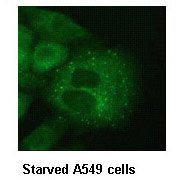Anti-Atg12 (Human) mAb
| Code | Size | Price |
|---|
| MBL-M154-3 | 100 uL | £341.00 |
Quantity:
Prices exclude any Taxes / VAT
Overview
Host Type: Mouse
Antibody Isotype: IgG1 κ
Antibody Clonality: Monoclonal
Antibody Clone: 6E5
Regulatory Status: RUO
Target Species: Human
Applications:
- Immunocytochemistry (ICC)
- Immunoprecipitation (IP)
- Western Blot (WB)
Shipping:
4°C
Storage:
-20°C
Images
Documents
Further Information
Applications:
WB - 1 ug/mL (chemiluminescence detection system) IP - 5 ug/250 uL of cell extract from 1x107 cells ICC - 10 ug/mL
Background:
Autophagy is a process of intracellular bulk degradation in which cytoplasmic components including organelles are sequestered within double-membrane vesicles that deliver the contents to the lysosome/vacuole for degradation. Autophagy has two ubiquitin-like conjugation systems, the Atg12 and LC3-II systems. In the Atg12 conjugation system, the Atg12-Atg5-Atg16L forms 800 kDa complex that elongates autophagic isolation membrane. After completion of the formation of the autophagosome, the Atg12-Atg5-Atg16L complex dissociates from the membrane.
Concentration:
1 mg/mL
Formulation:
100 ug IgG in 100 ul volume of PBS containing 50% glycerol, pH 7.2. No preservative is contained.
Gene IDs:
Human: 9140 Mouse: 67526
Immunogen Translated:
KLH-conjugated synthetic peptide (Human Atg12, internal reagion)
Reactivity:
This antibody reacts with human
Atg5-Atg12 complex (55 kDa) on Western blotting.
Because almost all Atg12 exist in the form of Atg5-Atg12
complex, it is difficult to detect the monomeric Atg12.
Shelf Life:
1 year
Source:
This antibody was purified from hybridoma
(clone 6E5) supernatant using protein A agarose. This
hybridoma was established by fusion of mouse myeloma
cell P3U1 with C3H mouse lymphocyte immunized with
the KLH conjugated synthetic peptide corresponding to
internal region of human Atg12.
Target:
Atg12
References
1) Mizushima, N., et al., J. Cell Sci. 116, 1679-1688 (2003)
2) Mizushima, N., et al., FEBS Lett. 532, 450-454 (2002)
3) Tanida, I., et al., J. Biol. Chem. 276, 1701-1706 (2001)





